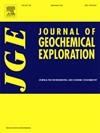A semi-supervised learning framework for intelligent mineral prospectivity mapping: Incorporation of the CatBoost and Gaussian mixture model algorithms
IF 3.4
2区 地球科学
Q1 GEOCHEMISTRY & GEOPHYSICS
引用次数: 0
Abstract
Semi-supervised learning warrants more significant consideration for machine learning-based mapping in mineral exploration, since mineral deposits frequently exhibit imbalances in occurrence frequencies. It can potentially address challenges associated with class imbalances via the efficient use of labeled data and the extrapolation of patterns from unlabeled data. This research endeavors to present a prospective model for Mississippi Valley-Type lead and zinc deposits employing a semi-supervised approach in the Varcheh district, western Iran. To achieve this goal, diverse exploratory criteria related to mineralization, encompassing geological, remote sensing, geochemical, and structural layers, have been incorporated to develop a semi-supervised mineral prospectivity model. The model strengthens the advantages of supervised and unsupervised learning approaches by incorporating the Categorical gradient Boosting (CatBoost) and Gaussian mixture model algorithms into a semi-supervised framework. This approach effectively utilizes limited labeled data, while capturing spatial patterns and relationships in the unlabeled dataset, ultimately contributing to a more robust mineral prospectivity mapping model. Indeed, the regions with high posterior probability include most lead and zinc deposits in this strategy, suggesting that the locations of known deposits are significantly tied to areas connected to high posterior probability. The semi-supervised proposed framework in this paper is also compared with supervised approach to validate the performance improvement. The implemented approach can be highly valuable for exploring resources.
一种用于智能矿产远景映射的半监督学习框架:结合CatBoost和高斯混合模型算法
半监督学习在基于机器学习的矿产勘探测绘中得到了更重要的考虑,因为矿床在出现频率上经常表现出不平衡。它可以通过有效地使用标记数据和从未标记数据中推断模式,潜在地解决与类不平衡相关的挑战。本研究旨在为伊朗西部Varcheh地区采用半监督方法的密西西比河谷型铅锌矿提供一个有前景的模型。为了实现这一目标,与矿化有关的各种勘探标准,包括地质、遥感、地球化学和构造层,已被纳入半监督矿物找矿模型。该模型通过将分类梯度增强(CatBoost)和高斯混合模型算法合并到半监督框架中,增强了监督学习和无监督学习方法的优势。该方法有效地利用了有限的标记数据,同时捕获了未标记数据集中的空间模式和关系,最终有助于建立更强大的矿产远景映射模型。事实上,在该策略中,具有高后验概率的区域包括大多数铅锌矿床,这表明已知矿床的位置与具有高后验概率的区域显著相关。并将本文提出的半监督框架与监督方法进行了比较,以验证其性能改进。实现的方法对于勘探资源非常有价值。
本文章由计算机程序翻译,如有差异,请以英文原文为准。
求助全文
约1分钟内获得全文
求助全文
来源期刊

Journal of Geochemical Exploration
地学-地球化学与地球物理
CiteScore
7.40
自引率
7.70%
发文量
148
审稿时长
8.1 months
期刊介绍:
Journal of Geochemical Exploration is mostly dedicated to publication of original studies in exploration and environmental geochemistry and related topics.
Contributions considered of prevalent interest for the journal include researches based on the application of innovative methods to:
define the genesis and the evolution of mineral deposits including transfer of elements in large-scale mineralized areas.
analyze complex systems at the boundaries between bio-geochemistry, metal transport and mineral accumulation.
evaluate effects of historical mining activities on the surface environment.
trace pollutant sources and define their fate and transport models in the near-surface and surface environments involving solid, fluid and aerial matrices.
assess and quantify natural and technogenic radioactivity in the environment.
determine geochemical anomalies and set baseline reference values using compositional data analysis, multivariate statistics and geo-spatial analysis.
assess the impacts of anthropogenic contamination on ecosystems and human health at local and regional scale to prioritize and classify risks through deterministic and stochastic approaches.
Papers dedicated to the presentation of newly developed methods in analytical geochemistry to be applied in the field or in laboratory are also within the topics of interest for the journal.
 求助内容:
求助内容: 应助结果提醒方式:
应助结果提醒方式:


